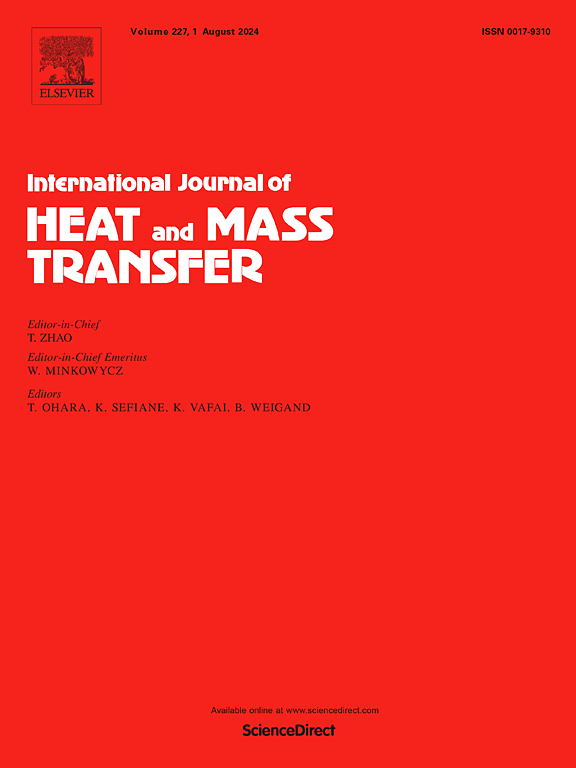用于北极寒冷地区钻井的井筒与永久冻土之间的水热耦合模型
IF 5
2区 工程技术
Q1 ENGINEERING, MECHANICAL
International Journal of Heat and Mass Transfer
Pub Date : 2024-09-25
DOI:10.1016/j.ijheatmasstransfer.2024.126236
引用次数: 0
摘要
北极寒冷地区丰富的石油和天然气资源促使人们在这些恶劣的环境中进行钻井作业。在北极冻土地区进行钻井作业时,钻井液在井筒内流动产生的线性热源效应会不断融化周围的冻土,从而导致井口沉降、井壁失稳等事故。为了给寒冷地区的钻井工程提供指导,迫切需要研究北极钻井中井筒与冻土之间的耦合传热。由于冻土中的水热耦合过程对温度传递有很大影响,传统的井筒传热模型并不适用。因此,本文提出了适用于北极寒冷地区钻井的井筒与冻土层水热耦合模型,并利用数值方法分析了井筒传热和地层水热过程。通过应用该模型,研究了现有主要井筒温度控制和隔热技术的隔热效果。主要研究结果表明,钻井过程会使井筒周围的冻土融化,井筒周围融化的冻土呈 "喇叭 "状,从井口向冻土层底部扩展;如果不采取保温措施,循环 7 天后,井筒周围融化的冻土体积可达 315 立方米;在钻井过程中,会发生水分迁移。在重力渗流作用下,井筒周围解冻冻土中的未冻水含量从井口到冻土层底部不断增加;真空隔热管材对井筒内钻井液温度的影响几乎可以忽略不计,但它可以使井筒周围的解冻冻土体积减少 62.钻井液冷却系统可以显著降低井筒内钻井液的温度,但不能有效防止井筒周围冻土的融化。因此,在实际钻井作业中,应优先考虑使用高质量的真空绝热管,或同时结合使用这两种方法。本文章由计算机程序翻译,如有差异,请以英文原文为准。
Hydrothermal coupling model between wellbore and permafrost for drilling in arctic cold regions
The abundant oil and natural gas resources in the Arctic cold regions have driven people to conduct drilling operations in these harsh environments. During drilling operations in Arctic permafrost regions, the linear heat source effect generated by the flow of drilling fluid in the wellbore continuously melts the surrounding permafrost, which can lead to wellhead settlement and instability of the wellbore wall, among other accidents. In order to provide guidance for drilling engineering in cold regions, there is an urgent need to study the coupled heat transfer between the wellbore and the permafrost in Arctic drilling. Due to the significant influence of hydrothermal coupling process in permafrost on temperature transfer, conventional wellbore heat transfer models are not suitable. Therefore, this paper proposes a hydrothermal coupling model between the wellbore and permafrost for drilling in Arctic cold regions and analyzes the heat transfer in the wellbore and the hydrothermal processes of the formation using numerical methods. By applying this model, the insulation effects of existing main wellbore temperature control and insulation technologies were studied. The main research findings indicate that drilling process can cause the permafrost around the wellbore to thaw, and the thawed permafrost around the wellbore presents a “horn” shape that expands from the wellhead to the bottom of permafrost layer; Without insulation measures, the volume of thawed permafrost around the wellbore can reach 315 m³ after 7 days of circulation; During the drilling process, moisture migration occurs. Under the effect of gravitational seepage, unfrozen water content in the thawed permafrsot around the wellbore increases from the wellhead to the bottom of the permafrsot layer; Vacuum insulated tubing has almost negligible impact on the temperature of the drilling fluid in the wellbore, while it can reduce the volume of thawed permafrost around the wellbore by 62.5 % to 88 % or even higher; Drilling fluid cooling systems can significantly lower the temperature of the drilling fluid in the wellbore but cannot effectively prevent the thawing of permafrost around the wellbore. Therefore, in practical drilling operations, priority should be given to using high-quality vacuum insulated tubing or combining both methods simultaneously.
求助全文
通过发布文献求助,成功后即可免费获取论文全文。
去求助
来源期刊
CiteScore
10.30
自引率
13.50%
发文量
1319
审稿时长
41 days
期刊介绍:
International Journal of Heat and Mass Transfer is the vehicle for the exchange of basic ideas in heat and mass transfer between research workers and engineers throughout the world. It focuses on both analytical and experimental research, with an emphasis on contributions which increase the basic understanding of transfer processes and their application to engineering problems.
Topics include:
-New methods of measuring and/or correlating transport-property data
-Energy engineering
-Environmental applications of heat and/or mass transfer

 求助内容:
求助内容: 应助结果提醒方式:
应助结果提醒方式:


